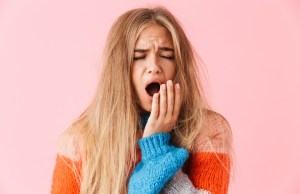Most lists of depression symptoms don’t quite capture the emotional weight of severe depression. Clinical facts about depression often fail to paint a full picture of how it feels to experience this mood disorder. What does depression feel like? Why is it so difficult to cope with? And what can be done to tackle its classic symptoms of hopelessness and despair?
This guide takes a closer look at the emotional, behavioral, and physical symptoms of depression. And if you recognize yourself or someone you love in this symptomatology, we give you an action plan for overcoming what William Styron described as depression’s “gray drizzle of horror.” The first step might be understanding where you stop and depression begins. You have to be able to say, “That’s not me; that’s my depression. And I can do something about it.” So let’s catalog the wide-ranging distress that can be caused by this common mental health disorder.

What Are the Signs of Depression?
Depression is a mood disorder with affective and physical symptoms that can vary from person to person, but the two defining symptoms of major depressive disorder (MDD) are 1) a depressed mood; and 2) loss of interest or pleasure (anhedonia).
1. In clinical terms, a depressed mood means that someone feels “sad,” “hopeless,” or “empty.” To outside observers, they might look “tearful.” But let’s contrast “sadness” with how the singer Bruce Springsteen describes his experience of depression:
“My depression is spewing like an oil spill all over the beautiful turquoise-green gulf of my carefully planned and controlled existence. Its black sludge is threatening to smother every last living part of me.”
And let’s contrast “hopelessness” with how the artist Vincent Van Gogh described one of his depressive episodes:
“One feels as if one were lying bound hand and foot at the bottom of a deep dark well.”
These wretched feelings can appear without explanation and completely overwhelm all the positive aspects of one’s life and identity. They go far beyond normal feelings of sadness or disappointment. They can feel…obliterating.
2. In clinical terms, anhedonia means that someone experiences “markedly diminished interest or pleasure in all, or almost all, activities.”
Do you normally take pride in your appearance? Do you normally like to call your best friend at the end of the day? Do you normally enjoy planning vacations or birthday parties? Depression can erase all those simple, familiar pleasures. You’re suddenly wandering from room to room, looking for any little thing that can spark happiness. But there’s nothing. And worse, you can’t access those old positive feelings, even in your memory.
A depressed mood and anhedonia are both deeply-felt emotional symptoms, but internal symptoms can also manifest externally, sending up red flags for loved ones. For example, a depressed person might:
- Stop taking care of themselves
- Quit showering or exercising routinely
- Begin eating junk food around the clock, or rarely consume anything nourishing at all, causing weight fluctuations
- Change their sleep habits, so instead of getting eight hours a night, they’re sleeping during the day, or experiencing insomnia
- Stop having sex with their partner because what used to feel good doesn’t feel good anymore
These new behaviors can cause a negative feedback loop that worsens someone’s depressive symptoms.
Depression symptoms can also be cognitive, affecting concentration, memory, and decision-making. For example, a depressed person may:
- Stare for hours at the coffee maker, unsure whether to start it or not
- Find it impossible to focus on simple tasks at work
- Space out while driving home or getting dressed in the morning due to their dark ruminations
- Take a long time to get their words out
Depression symptoms can be physical, with some people feeling:
- Restless or agitated
- Sluggish
- Excessively tired
- Achy or in pain
They might go to their doctor seeking help for their mysterious headaches or stomach distress, only to be told that there’s nothing physically wrong with them.
And worst of all, depression symptoms can be deadly. People with depression are at higher risk of having suicidal thoughts or attempting suicide. They may become so desperate to end their mental suffering that they make an irrevocable decision. Suicide leaves friends and family in agony, and the depressed person never gets a chance to feel better. People with depression must seek immediate help if their symptoms begin to threaten their lives.
Major Depression Symptoms DSM-5
If you’re looking for the clinical criteria for diagnosing major depressive disorder (MDD), the Diagnostic and Statistical Manual of Disorders (DSM-5), published by the American Psychiatric Association (APA), lists nine depression symptoms. Only five of them need to be present for a mental health professional to make a clinical diagnosis of MDD in an adult:
1. You must have a depressed mood OR loss of interest or pleasure (anhedonia) for at least two weeks, most of the day, nearly every day.
2. You must also experience 3-4 of the following:
- Appetite changes
- Sleep issues including initial, middle, and terminal insomnia
- Observable psychomotor agitation or retardation (slowing down)
- Excessive fatigue
- Feelings of worthlessness or profound guilt
- Cognitive impairments (e.g., poor concentration)
- Suicidal ideation or thoughts of death (do not need to be present every day)
3. Your symptoms must be causing significant problems in your life.
4. You must be able to rule out other causes (like medication, substance abuse, or another mental health condition) for these mood changes.
Taken together, the above signs of depression also comprise depressive episode symptoms.
The DSM-5 provides further ways to classify MDD: by severity or course specifier and by additional features. A clinician can code major depression in any of the following ways:
- Mild
- Moderate
- Severe
- With psychotic features
- In partial remission
- In full remission
- Unspecified
A mental health professional may also diagnose major depression with any of the following specifiers:
- With anxious distress
- With mixed features
- With melancholic features
- With atypical features
- With mood-congruent psychotic features
- With mood-incongruent psychotic features
- With catatonia
- With peripartum onset
- With seasonal pattern
How Depression Symptoms May Vary
Depression symptoms are both individual and dimensional. They can be affected by age, gender, cultural norms, and much more. And they can range from mild to severe. Here are some notable differences in how depression symptoms may manifest across demographics.
Depression Symptoms in Women
Women are diagnosed with depression about twice as often as men. They are also uniquely susceptible to the following:
- Premenstrual dysphoric disorder
- Perinatal depression
- Perimenopausal depression
Depression Symptoms in Men
Men with depression may be more reluctant to talk about their feelings of sadness due to perceived gender roles. Sometimes these sad feelings can manifest as increased irritability, frustration over minor matters, or angry outbursts. Some men might downplay their symptoms or resist professional treatment. Depression symptoms in men may also include the following:
- Escapist behavior
- Physical complaints
- Risky or reckless behavior
- Alcohol or drug use (sometimes used as a maladaptive coping strategy)
Depression Symptoms in Children
Children with depression can also express irritability rather than sadness. Parents and caregivers may also see the following depression symptoms:
- Drop in grades at school
- Failure to meet expected weight gains
- Separation anxiety or clinginess
- Refusal to go to school
- Worry and anxiety
- Body aches and pains
Depression Symptoms in Teens
Teenagers with depression may have poor attendance at school, or their grades may suffer. They can also exhibit any of the following signs of depression:
- Hypersomnia (sleeping too much)
- Hyperphagia (abnormally increased appetite)
- Personality disturbances
- Extreme sensitivity
- Drug and/or alcohol use
- Social avoidance
- Apathy
- Self-harming behaviors
Depression Symptoms in Older Adults
Older adults and the elderly may exhibit memory difficulties in addition to a melancholy mood and psychomotor disturbances. This is why depression in older adults can sometimes be mistaken for dementia (pseudodementia).
What Are the 3 Levels of Depression?
Depression symptoms can range from mild to severe, based on someone’s degree of functioning.
Mild Depression Symptoms
If someone has mild depression, their symptoms might not be as noticeable to an outside observer. Their functioning may appear relatively normal, with others not recognizing how much extra effort is required to maintain that appearance. Someone with mild depression might also dismiss their symptoms as just being “the blues” or normal sadness. But if they meet the DSM-5 criteria for a depressive disorder, then they have depression, and could benefit from treatment.
Mild depression symptoms are less intense versions of those standard DSM-5 diagnosis criteria. For example, someone with mild depression might experience the following:
- Lack of motivation
- Increase in maladaptive coping behaviors like drinking or gambling
- Withdrawal from friends
- Irritability
- Daytime sleepiness
- Flu-like symptoms
Moderate Depression Symptoms
The next level of depression symptoms tends to have a greater impact on functioning. These symptoms can affect a person’s:
- Social life
- Romantic life
- Productivity
- Self-esteem
- Weight
- Energy levels
Severe Depression Symptoms
On the far end of the symptom spectrum, someone with severe depression might wrestle with the most intense feelings of darkness and despair. Severe symptoms can include the following:
- Hallucinations or delusions
- Complete inaction (stupor or catatonia)
- Reckless behavior
- Suicidal thoughts or plans
Someone with severe depression symptoms may pose a danger to themselves. In order to get treatment at this point, they may need the support of friends or family. Severe depression can render someone virtually helpless, unable to make that first phone call to a mental health professional.
What Are the 7 Forms of Depression?
All forms of depression are characterized by changes in mood, energy, and cognition that make it harder to function in the world. Specific types of depression can be distinguished by how long they last, when they occur, and why they occur. According to the DSM-5, there are eight types of depressive disorder:
- Disruptive mood dysregulation disorder (in children only)
- Major depressive disorder
- Persistent depressive disorder (formerly known as dysthymia )
- Premenstrual dysphoric disorder
- Substance/medication-induced depressive disorder
- Depressive disorder due to another medical condition
- Other specified depressive disorder
- Unspecified depressive disorder
But many sources deviate from the DSM-5 taxonomy and instead enumerate seven of the most common forms of mood disorder. (Mood disorders include both depressive disorders and bipolar disorders.) These are the following:
- Major depressive disorder (MDD)
- Persistent depressive disorder
- Bipolar depression (which, along with mania or hypomania, is one of the poles of bipolar I or bipolar II disorder)
- Postpartum depression (which is MDD with peripartum onset)
- Premenstrual dysphoric disorder
- Seasonal affective disorder (which is MDD with seasonal pattern)
- Atypical depression (which is MDD with atypical features)
What Are the Top 3 Causes of Depression?
Complex factors can lead to the development of depression. The American Psychiatric Association (APA) offers three main causes of depression:
- Environmental (e.g., abuse, poverty, neglect, and other stressors)
- Temperamental (e.g., neurotic personality traits)
- Genetic and physiological (e.g., family history and brain structure)
People with other physical and mental disorders are also at higher risk of developing depression.
How Does Depression Affect the Brain?
Neuroscientists have identified a few abnormalities in the brains of people with depression, but the results of these neuroanatomical, neuroendocrinological, and neurophysiological studies aren’t yet definitive. The hypothalamic-pituitary-adrenal axis (HPA axis) is frequently implicated in this depression research. But because depression is such a heterogeneous disorder, scientists can’t pinpoint a single biological origin, such as low serotonin levels.
What Must Be Done to Avoid Depression?
There may be no surefire way to avoid depression, but that should not stop anyone from taking preventative measures. Mental health professionals know steps you can take now to protect your brain in the future:
- Learn healthy coping skills and emotional regulation
- Hack brooding rumination
- Find social support and community
- Eat nourishing food that may give your mental health a boost
- Stick to healthy sleep patterns to ward off chronodisruption
- Get regular physical activity
- Know your family history and risk factors (part of psychoeducation)
- Improve your quality of life
- Build resilience
- Love your body
- Cultivate self-esteem
If you have a history of depression and want to lower your risk of relapsing, adhere to a treatment plan that has worked in the past. Consult with your doctor before you stop taking your antidepressant medication and think hard before terminating therapy. You may need to accept the idea that depression will be a chronic, long-term condition, not something that you can dismiss permanently once you’re feeling better.
What Are the Warning Signs for Suicide?
Not everyone with clinical depression will exhibit suicidal thoughts or behaviors, but vigilance is critical when the stakes are so high. The following signs may indicate that someone is at risk of attempting or completing a suicide:
- Frequent talk of death
- Offhand comments about the world being better without them
- Feeling like a burden
- Worsening depression symptoms
- Risky or reckless behaviors
- Suddenly becoming calm, cheery, or reenergized
- Getting rid of possessions or putting one’s affairs in orders
- Reaching out to friends to deliver final messages
- Acquiring a firearm or other materials as part of a plan
If you are concerned about suicide, you can reach out 24/7 to a free, confidential, national helpline:
- Substance Abuse and Mental Health Services Administration (SAMHSA) at 1-800-662-HELP (4357)
- Suicide Prevention Lifeline at 988
How Can Therapy Help with Depression?
Why see a therapist for depression? Because depression is highly treatable, especially with early intervention. And therapy can help from the very first sessions when a mental health professional might accurately identify what’s going on in your life, and give you a name for your symptoms. Then you can begin the process of extricating yourself from your depression and reclaiming your life.
Here are some of the main evidence-based depression treatments that therapists, psychiatrists, counselors, clinical social workers, and other mental health professionals might utilize to address the signs and symptoms of depression:
- Depression medications
- Psychological skills training
- Mindfulness training
- Lifestyle modifications addressing diet and exercise
- Psychotherapy (talk therapy) approaches
- Supportive counseling
- Behavioral therapies like cognitive behavioral therapy (CBT)
Recovery from depression might take weeks, months, or years. Mastering the symptoms of this disorder often requires pharmacological and/or therapeutic interventions. And it may feel daunting to ask for help. But just like any other serious health issue, depression shouldn’t be ignored. Even if your life isn’t at stake, your well-being is. You deserve a better life than what depression dictates. You deserve to feel joy again–and by prioritizing your care, you will.













